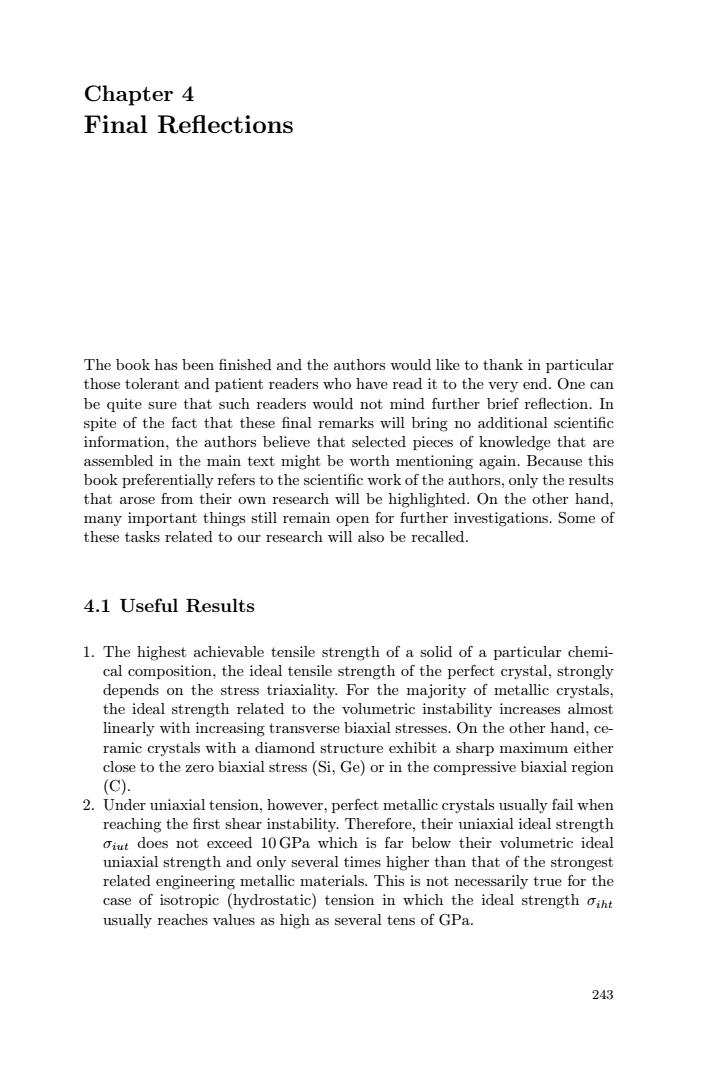正在加载图片...

Chapter 4 Final Reflections The book has been finished and the authors would like to thank in particular those tolerant and patient readers who have read it to the very end.One can be quite sure that such readers would not mind further brief reflection.In spite of the fact that these final remarks will bring no additional scientific information,the authors believe that selected pieces of knowledge that are assembled in the main text might be worth mentioning again.Because this book preferentially refers to the scientific work of the authors,only the results that arose from their own research will be highlighted.On the other hand, many important things still remain open for further investigations.Some of these tasks related to our research will also be recalled. 4.1 Useful Results 1.The highest achievable tensile strength of a solid of a particular chemi- cal composition,the ideal tensile strength of the perfect crystal,strongly depends on the stress triaxiality.For the majority of metallic crystals, the ideal strength related to the volumetric instability increases almost linearly with increasing transverse biaxial stresses.On the other hand,ce- ramic crystals with a diamond structure exhibit a sharp maximum either close to the zero biaxial stress(Si,Ge)or in the compressive biaxial region (C). 2.Under uniaxial tension,however,perfect metallic crystals usually fail when reaching the first shear instability.Therefore,their uniaxial ideal strength oiut does not exceed 10 GPa which is far below their volumetric ideal uniaxial strength and only several times higher than that of the strongest related engineering metallic materials.This is not necessarily true for the case of isotropic (hydrostatic)tension in which the ideal strength oiht usually reaches values as high as several tens of GPa. 243Chapter 4 Final Reflections The book has been finished and the authors would like to thank in particular those tolerant and patient readers who have read it to the very end. One can be quite sure that such readers would not mind further brief reflection. In spite of the fact that these final remarks will bring no additional scientific information, the authors believe that selected pieces of knowledge that are assembled in the main text might be worth mentioning again. Because this book preferentially refers to the scientific work of the authors, only the results that arose from their own research will be highlighted. On the other hand, many important things still remain open for further investigations. Some of these tasks related to our research will also be recalled. 4.1 Useful Results 1. The highest achievable tensile strength of a solid of a particular chemical composition, the ideal tensile strength of the perfect crystal, strongly depends on the stress triaxiality. For the majority of metallic crystals, the ideal strength related to the volumetric instability increases almost linearly with increasing transverse biaxial stresses. On the other hand, ceramic crystals with a diamond structure exhibit a sharp maximum either close to the zero biaxial stress (Si, Ge) or in the compressive biaxial region (C). 2. Under uniaxial tension, however, perfect metallic crystals usually fail when reaching the first shear instability. Therefore, their uniaxial ideal strength σiut does not exceed 10 GPa which is far below their volumetric ideal uniaxial strength and only several times higher than that of the strongest related engineering metallic materials. This is not necessarily true for the case of isotropic (hydrostatic) tension in which the ideal strength σiht usually reaches values as high as several tens of GPa. 243